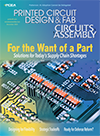Features Articles

Twenty years has passed since the US was a world leader in printed circuit board fabrication production. And not just in revenues, which tended to run neck-and-neck with Japan. The US also had the capability and capacity to build the largest-format boards in volume.
That was 2000.
I remember talking with Jack Fisher, then the technical director of the tech consortium ITRI, about the coming year. We were reviewing the latest bullish industry forecasts, in which some of the major fabricators were quoting lead-times of six to 12 months(!).
That unbridled optimism prompted Jack to observe that any hope of the US investing in HDI technology would be pushed out at least another year. Since order books were full for large boards, fabs saw no need to invest in next-generation technology.
Or so they thought. Because, as we all know, then the dot-com crash occurred.
It’s hard to believe that was 20 years ago. But we might be edging toward history repeating.
To continue reading, please log in or register using the link in the upper right corner of the page.

Affordable and accessible technologies are the key to global progress.
My smartphone does everything so well I hardly use my tablet or laptop at all. It contains all the apps I need to use every day, is always with me and always connected, and the clarity of the screen makes it a pleasure to handle the majority of computing tasks on this device. I am convinced improvements in display technologies have helped the smartphone become the go-to device for a vast number of daily activities.
To support the best possible experiences in video, photography and gaming, new display technologies continue to emerge to provide seamless, immersive viewing. OLED displays are dominating the smartphone and flat-panel television markets, bringing attributes such as conformability and optical performance, including high contrast ratio with the ability to render true black, which conventional LCDs cannot manage.
But we humans are insatiable by nature. If the color is good, the viewing angle could be a little wider. If the angle is okay, the contrast could be higher. Now, another change is in progress with the arrival of mini-LED backlit LCDs. Containing many thousands of individual mini-LED emitters less than 0.2mm in size, the backlight has many dimmable zones and permits deep black levels, high contrast ratio and high luminance.
To continue reading, please log in or register using the link in the upper right corner of the page.

When through-hole connectors move during soldering, damage to the nozzle ensues.
This month we we look at through-hole connectors and component pin float. All connector pins should be held in place by the body molding and not move during soldering. The connector should not be used outside of its specification. Suppliers typically define the temperature and time the pins and body of the part are exposed to a specific peak temperature. It is the designer’s job to ensure the correct parts are defined for the process. It is the purchasing department’s job to ensure the correct parts are ordered.
In the images shown, the pins in the connector have floated down. This happens easily during soldering or rework. In an automated process, if the pins drop down 1 to 2mm below the board in selective or wave soldering, they can cause damage. Pins can contact the solder nozzle or wave former, which will jam the machine. Using low-temperature solder with a lower specification connector will work fine, but consider the rework temperatures if parts must be removed.
To continue reading, please log in or register using the link in the upper right corner of the page.

Questions to ask before action is taken.
Most who perform statistical analyses that guide organizations to solve problems do not have advanced degrees in statistics. We’ve attended classes at university, engaged in varying levels of Six Sigma training, or conducted self-study.
But I think it is safe to say we all have learned that statistically evaluating a set of data is complicated and rife with uncertainty. We choose among many possible statistical tools, and numbers “pop” out telling us if our hypothesis is correct. From those data, we proceed to either take an action or not take an action, depending on the statistical results.
Yet how many finish an analysis and wonder what if it is wrong? Did I have enough data? Did I choose the proper statistical tool? Do I even know the proper statistical tool? Arghh! (I suspect doctors of statistical science also have “arghh” moments.)
To continue reading, please log in or register using the link in the upper right corner of the page.

Why you should consider a certification program.
When I look back on my career and consider the key ingredient to my success, I’d say whenever opportunity knocked, I had the right skill set to walk through the door. I was fortunate that my first electronics manufacturing services (EMS) employer had both a tuition refund program that paid for my master’s degree in management and an internal management training program. That started me on a path of continuous learning that included multiple certification programs and other training programs. And, as advancement opportunities came up, I had the right qualifications and a results-focused track record.
Company-sponsored educational resources are more limited today. That said, technology has made it possible and convenient to engage in focused continuous learning opportunities. IPC’s Certified Electronics Program Manager (CEPM) training and certification program is a good example. What once required multiple trips to training locations and a solid week of classroom time can now be done via computer either in live sessions or through reviews of class recordings. The program was redesigned to an online format in 2017 and now is a six-week program with two two-hour classes per week, providing overviews of program management, sales, cost accounting, materials management, contracts, production planning, quality and leadership. Students are assigned to teams that complete a case study each week related to the concepts presented. A variety of online exercises reinforce key concepts. The goal is to ensure participants are provided a common framework of knowledge and the opportunity to interact with peers to discuss best practices. Information on the program and upcoming dates is available here: https://training.ipc.org/product/certified-electronics-program-manager-cepm-program.
To continue reading, please log in or register using the link in the upper right corner of the page.

Businesses can’t plan for everything, but with the right prep they can adapt.
December is finally here. Mercy knows it seems to have taken forever to bring this most unusual year to a close. I keep pondering the question customers inevitably ask during a supplier audit: What contingencies are in place for “unforeseen and unthinkable” disasters and events? If anyone had asked me a couple years ago to come up with a plan to deal with a global pandemic I would have thought them to be crazy for asking. And yet, that was 2020!
The one takeaway from this crazy year is you can never plan for everything. Paradoxically, good planning makes it easier to deal with the unimaginable.
Business planning takes numerous forms. Most people think first of the financial budget planning, usually led by finance and account staffs. Visions of building a budget, whether bottom-up or top-down, as a tool to measure specific activities against comes to mind. This type of planning revolves around predicting core operating activities that are repeatable, predictable and highly measureable. While important, if not essential, for the operations folk to run the “business as usual,” that budget is only one aspect of planning.
To continue reading, please log in or register using the link in the upper right corner of the page.


